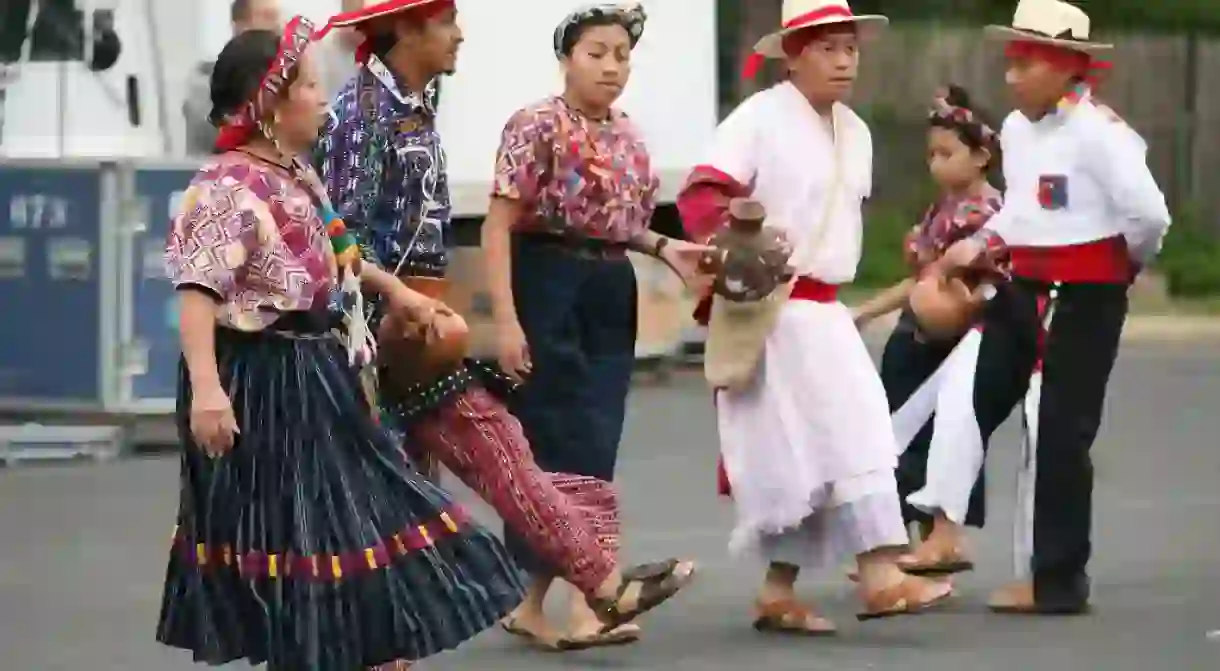7 Traditional Folk Dances of Guatemala You Should Know

Guatemala is known for its fascinating culture, which merges indigenous Mayan histories with colonial traditions. Dance is an important part of Guatemalan culture, and the folk dances that are still performed here today are a meaningful reflection of both Mayan and Spanish cultures. Essentially divided into two groups – pre-Hispanic and Hispanic – here are seven traditional folk dances of Guatemala you should know.
Danza de los monos (Dance of the Monkeys)
A pre-Hispanic dance, the Dance of the Monkeys recalls an ancient myth recorded in the sacred Mayan book Popol Vuh. In the story, twin brothers are turned into monkeys as punishment for the envy they felt for their older siblings. The dance features a 35-foot pole erected in front of a church; the dancer playing the monkey must balance on a piece of rope tied between the pole and church. This dance is performed by 23 people, with music from a simple marimba and a special flute called an Ah Xul.
Danza de la Conquista (Dance of the Conquest)
As its name suggests, the Dance of the Conquest has Hispanic Colonial origins. It references the death of Mayan king Tecun Uman, who died valiantly in battle while trying to protect his people. The other main character in the dance is Pedro Alvarado, the conqueror of Guatemala, and the finale of the dance references the Maya being converted to Christianity. At this point, the Maya and the Spanish dance together, forgetting their differences. The instruments accompanying the dance are the whistle, the chimirría flute and the drums.

Danza de los Venados (Dance of the Deer)
This dance is of pre-Hispanic origin and references the hunting of deer for food and sustenance. Directed by a Maya priest, the dance features 26 dancers, with a single marimba providing the music, and represents the struggle between humans and animals for meat. During the dance, groups of young men with dogs must fight off lions and tigers in order to claim the deer for their own. When the dance has concluded a feast begins, and all the guests are offered meat.
Danze de los Vaqueros (Dance of the Cowboy)
The Dance of the Cowboys is of Hispanic Colonial origin, and this complicated dance is one of the most deeply-rooted in Guatemalan popular culture. The dance exclusively references Spanish traditions like bullfighting and cattle breeding, which were introduced to Guatemala in the second half of the 16th century. Due to its mocking nature, the dance is considered satirical. There are 32 participants in this dance, with characters including a hacienda owner, young women, bosses, cowboys, shepherds and bulls.

Danze de los Mexicanos (Dance of the Mexicans)
The Dance of the Mexicans is another that has its origins in cattle breeding. Introduced in Guatemala in the early 19th century, the dance was first performed by the Chiapas in Mexico, to honor the Virgin of Guadalupe. The dance made its way south to Guatemala, and after the Mexican Revolution took on some new features, such as pistols in the dancers’ belts and cartridge belts strapped across their chests. The dance satirizes the life of the Spanish during the colonial era, and accompanying music comes from a marimba, saxophone and trumpet.
Danza de los Pascarines (Dance of the Pascarines)
The Dance of the Pascarines is of Hispanic colonial origin, and tells the adulterous story of two shepherds who fight over a woman. Despite its pastoral theme, the dance is unusually aggressive: it involves the use of leather whips against some of dancers – particularly the dancer who plays the adulterer – and they have to rest in bed for several days afterwards. The dance usually takes place in April, with 25 dancers taking part.

Danza de Moros y Cristianos (Dance of the Moors and Christians)
Of Hispanic Colonial origin, this dance tells the story of Iberia’s reconquest of Spain. Covering a time period of nearly 800 years, the dance recalls the Spanish struggle against the Arabs, and highlights the power of the Christian God who allowed them to prevail against the Moors. The dance was introduced to Guatemala by missionaries in an attempt to convert the Maya to Christianity. The dance traditionally takes place on June 30, with ten dancers accompanied by a drum and flute.













